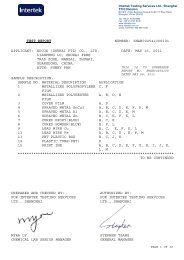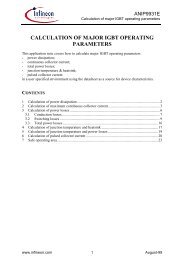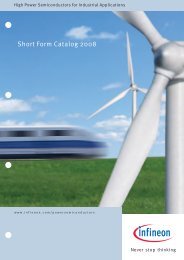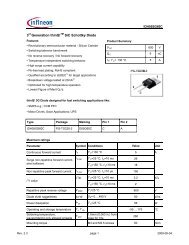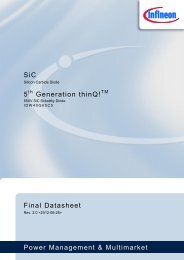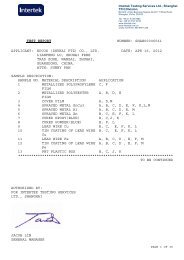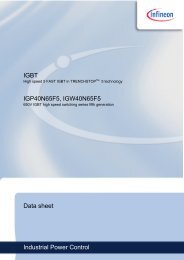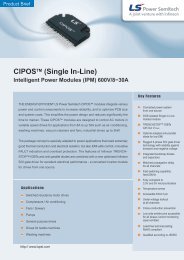DN-CIPOS-1.pdf - Infineon
DN-CIPOS-1.pdf - Infineon
DN-CIPOS-1.pdf - Infineon
You also want an ePaper? Increase the reach of your titles
YUMPU automatically turns print PDFs into web optimized ePapers that Google loves.
Design Note, V1.0, Jul.2008<br />
Control integrated Power<br />
System (<strong>CIPOS</strong> TM )<br />
Neglibible impact of oxidized copper<br />
on the performance of <strong>CIPOS</strong> TM<br />
products<br />
<strong>DN</strong>-<strong>CIPOS</strong>-1<br />
Author: J. Oehmen<br />
http://www.infineon.com/cipos<br />
Power Management and Drives
Revision History: 2008-07 V1.0<br />
Previous Version:<br />
none<br />
Page<br />
Subjects (major changes since last revision)<br />
all<br />
First release<br />
Edition 2008-07-28<br />
Published by<br />
<strong>Infineon</strong> Technologies AG<br />
81726 München, Germany<br />
© <strong>Infineon</strong> Technologies AG 2008.<br />
All Rights Reserved.<br />
Attention please!<br />
THE INFORMATION GIVEN IN THIS APPLICATION NOTE IS GIVEN AS A HINT FOR THE<br />
IMPLEMENTATION OF THE INFINEON TECHNOLOGIES COMPONENT ONLY AND SHALL NOT BE<br />
REGARDED AS ANY DESCRIPTION OR WARRANTY OF A CERTAIN FUNCTIONALITY, CONDITION OR<br />
QUALITY OF THE INFINEON TECHNOLOGIES COMPONENT. THE RECIPIENT OF THIS APPLICATION<br />
NOTE MUST VERIFY ANY FUNCTION DESCRIBED HEREIN IN THE REAL APPLICATION. INFINEON<br />
TECHNOLOGIES HEREBY DISCLAIMS ANY AND ALL WARRANTIES AND LIABILITIES OF ANY KIND<br />
(INCLUDING WITHOUT LIMITATION WARRANTIES OF NON-INFRINGEMENT OF INTELLECTUAL<br />
PROPERTY RIGHTS OF ANY THIRD PARTY) WITH RESPECT TO ANY AND ALL INFORMATION GIVEN<br />
IN THIS APPLICATION NOTE.<br />
Information<br />
For further information on technology, delivery terms and conditions and prices please contact your nearest<br />
<strong>Infineon</strong> Technologies Office (www.infineon.com).<br />
Warnings<br />
Due to technical requirements components may contain dangerous substances. For information on the types<br />
in question please contact your nearest <strong>Infineon</strong> Technologies Office.<br />
<strong>Infineon</strong> Technologies Components may only be used in life-support devices or systems with the express<br />
written approval of <strong>Infineon</strong> Technologies, if a failure of such components can reasonably be expected to<br />
cause the failure of that life-support device or system, or to affect the safety or effectiveness of that device or<br />
system. Life support devices or systems are intended to be implanted in the human body, or to support<br />
and/or maintain and sustain and/or protect human life. If they fail, it is reasonable to assume that the health<br />
of the user or other persons may be endangered.
<strong>DN</strong>-<strong>CIPOS</strong>-1<br />
Oxidized copper layer on <strong>CIPOS</strong> TM products<br />
Table of contents<br />
1 Introduction ...................................................................................................................................4<br />
2 Thermal performance of <strong>CIPOS</strong> TM products...............................................................................4<br />
3 Conclusion.....................................................................................................................................5<br />
Design Note 3 V1.0, 2008-07
<strong>DN</strong>-<strong>CIPOS</strong>-1<br />
Oxidized copper layer on <strong>CIPOS</strong> TM products<br />
1 Introduction<br />
<strong>CIPOS</strong> modules comprise direct copper bonded (DCB) substrates offering a low thermal resistance. The<br />
backside of such a substrate is formed by a copper layer being directly accessible for cooling purposes. Due<br />
to the contact with air during storage, the surface of this layer may oxidize. This yields a non-uniformly<br />
distributed thin oxide layer consisting mainly of copper oxide (Cu 2 O / CuO) which does not affect the<br />
electrical or the thermal performance of the module. Such layers shine in different colors depending on its<br />
thicknesses (typically brown or silver).<br />
2 Thermal performance of <strong>CIPOS</strong> TM products<br />
<strong>CIPOS</strong> TM products need to be cooled. Being attached to heat sinks, thermal grease is typically used in order<br />
to provide a good thermal contact between the module and the heat sink. Frequently used thermal greases<br />
have typically a thermal conductivity of 1 W/mK. In most cases one can assume a thermal grease thickness<br />
of about 100 µm.<br />
Mold Compound<br />
IGBT<br />
Die attach<br />
Copper<br />
Thermal<br />
grease<br />
Al 2 O 3<br />
Copper<br />
Oxidized<br />
copper<br />
Heat sink<br />
Figure 1: Simplified crosscut through the DCB of a <strong>CIPOS</strong> TM module.<br />
When the system is properly cooled, one of the main factors determining its thermal impedance is the<br />
thermal grease. Characteristic of such a layer of thermal grease is the property R th,grease •A= 100µ K/W•m 2<br />
being much higher than the one of other layers (see Table 1).<br />
Design Note 4 V1.0, 2008-07
<strong>DN</strong>-<strong>CIPOS</strong>-1<br />
Oxidized copper layer on <strong>CIPOS</strong> TM products<br />
Layer<br />
Thickness<br />
[mm]<br />
Thermal conductivity<br />
@ 100°C [W/mK]<br />
Rth*A<br />
[W/K*m^2]<br />
Copper 0.3 385 7.79E-07<br />
Al 2 O 3 0.38 23 1.65E-05<br />
Thermal grease 0.1 1 1.00E-04<br />
Oxidized Copper 0.0001 10 1.00E-08<br />
Table 1: Rth*A of different layers<br />
Oxidized copper layers are typically very thin (the thickness hardly reaches 100 nm). The thermal<br />
conductivity of copper oxides ranges approximately from 10 W/mK to 40 W/mK. This yields at worst<br />
R th,ox.Cu •A= 0.01µ K/W•m 2 . As heat spreading is negligible in such a thin layer, the heat flow through these<br />
layers covers the same area. Hence, the thermal resistance of the thermal grease will be approximately<br />
10 000 times higher than the thermal resistance of the oxidized copper:<br />
R<br />
th,grease<br />
≥ 10000 ⋅ R<br />
th,ox. Cu<br />
Even if one could provide an ideal thermal contact between module and heat sink, the thermal resistance of<br />
the DCB is much larger than that of the oxidized copper. Thus, the oxidized copper does not affect the<br />
thermal performance of the module.<br />
3 Conclusion<br />
It has been shown by assessing the thickness and thermal conductivity of different layers of a mounted<br />
<strong>CIPOS</strong> TM module that oxidized copper layers have no impact on the thermal performance.<br />
Design Note 5 V1.0, 2008-07
http://www.infineon.com<br />
Published by <strong>Infineon</strong> Technologies AG



